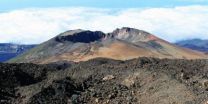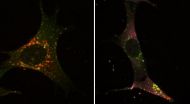(Press-News.org) The potential of GMES for crisis management and environmental monitoring is highlighted in a new publication with users demonstrating the importance of Earth observation data to European regions.
The joint ESA-NEREUS (Network of European Regions Using Space Technologies) publication is a collection of articles that provide insight into how the Global Monitoring for Environment and Security (GMES) programme is being used in new applications and services across Europe.
The articles, prepared by regional end-users, research institutes and industry providers from 17 different European countries, were received following an open call for papers.
Papers were grouped according to the thematic GMES domains land, maritime, atmosphere, climate and emergency management. They highlight a wide range of uses, needs and benefits of the initiative for regional organisations.
Among the 67 articles published, one outlines how satellites can be used for water quality monitoring of Hungary's Lake Balaton.
The Balaton Limnological Institute used satellite imagery to observe substances suspended or dissolved in the lake's water to measure water quality conditions.
The article concludes by noting that the future Sentinel-2 satellite being developed for GMES will benefit the project by providing the necessary high-resolution data.
Another project generates flood risk maps along the Danube River, with a focus on monetary asset values and population distribution and density.
The products can help decision-makers to prioritise response actions, deployment of resources and justify cost-benefit prevention and response measures.
At an event held on 10 October at the European Parliament in Brussels, the collection titled 'The Growing Use of GMES across Europe's Regions' was presented.
Opening the event, Member of the European Parliament Norbert Glante, said, "The European Parliament is fully supportive of GMES. It is a large-scale infrastructure project of strategic importance for the EU's competiveness."
Director of ESA's Earth Observation Programmes, Volker Liebig, explained the benefits that the future Sentinel satellites can bring to European citizens. He also stressed that the Sentinels are a major improvement compared to existing missions.
"The SAR instrument on the two Sentinel-1 satellites, for example, will have 12 times the observation capacity of the ASAR instrument on Envisat," said Prof. Liebig.
"Sentinel-2, with 13 spectral channels and a global coverage every of five days between the two satellites, will provide operational data not available before for many applications."
The large response when collecting case examples was highlighted by NEREUS Vice-President Alan Wells: "We intended to publish 50 cases, but the response was so good that we ended up publishing almost 70. And there are many more examples that could be shown."
GMES is becoming an indispensible tool for regional policy-making. Satellite data can be exploited to support sustainable environmental protection with a long-term perspective, thereby contributing to better-informed decision-making down to a local level.
### END
GMES for Europe
2012-10-12
ELSE PRESS RELEASES FROM THIS DATE:
Development of 2 tests for rapid diagnosis of resistance to antibiotics
2012-10-12
With their excellent sensitivity and specificity, the use of these extremely efficient tests on a world-wide scale would allow us to adapt antibiotic treatments to the individual's needs and to be more successful in controlling antibiotic resistance, particularly in hospitals. These works were published in September in two international reviews:
Emerging Infectious diseases and The Journal of Clinical Microbiology.
These diagnostic tests will allow rapid identification of certain bacteria that are resistant to antibiotics and hence:
Allow us to better adapt the treatment ...
Scientists identify trigger for explosive volcanic eruptions
2012-10-12
Scientists from the University of Southampton have identified a repeating trigger for the largest explosive volcanic eruptions on Earth.
The Las Cañadas volcanic caldera on Tenerife, in the Canary Islands, has generated at least eight major eruptions during the last 700,000 years. These catastrophic events have resulted in eruption columns of over 25km high and expelled widespread pyroclastic material over 130km. By comparison, even the smallest of these eruptions expelled over 25 times more material than the 2010 eruption of Eyjafjallajökull, Iceland.
By analysing ...
The body's own recycling system
2012-10-12
Almost everything that happens inside a cell, including autophagy, is tightly regulated on a biochemical level. Like that, the cell makes sure that processes only take place when they are needed and that they are shut off when the need has expired. "Inside the cell, there exists a network of molecules. Between them, information is constantly being exchanged," says Schmitz, head of the research group "Systems-oriented Immunology and Inflammation Research" at HZI, who also holds a chair at the Otto von Guericke University in Magdeburg. "In a way, it looks like a big city ...
The worst noises in the world: Why we recoil at unpleasant sounds
2012-10-12
In a study published in the Journal of Neuroscience and funded by the Wellcome Trust, Newcastle University scientists reveal the interaction between the region of the brain that processes sound, the auditory cortex, and the amygdala, which is active in the processing of negative emotions when we hear unpleasant sounds.
Brain imaging has shown that when we hear an unpleasant noise the amygdala modulates the response of the auditory cortex heightening activity and provoking our negative reaction.
"It appears there is something very primitive kicking in," says Dr Sukhbinder ...
Kidney grafts function longer in Europe than in the United States
2012-10-12
Kidney transplants performed in Europe are considerably more successful in the long run than those performed in the United States. While the one-year survival rate is 90% in both Europe and the United States, after five years, 77% of the donor kidneys in Europe still function, while in the United States, this rate among white Americans is only 71%. After ten years, graft survival for the two groups is 56% versus 46%, respectively. The lower survival rates compared to Europe also apply to Hispanic Americans, in whom 48% of the transplanted kidneys still function after ten ...
Neuroscientists from Louisiana Tech University to present at international conference
2012-10-12
RUSTON, La. – Dr. Mark DeCoster, the James E. Wyche III Endowed Professor in Biomedical Engineering at Louisiana Tech University, will lead a team of Louisiana Tech neuroscientists in presenting a lecture at the Society for Neuroscience's (SfN) annual meeting, October 15 in New Orleans.
The lecture titled, "Randomization of submaximal glutamate stimulus to interpret astrocyte effect on calcium dynamics," will be featured as part of Neuroscience 2012 – SfN's annual meeting that provides the world's largest forum for neuroscientists to debut research and network with colleagues ...
'Invisibility' could be a key to better electronics
2012-10-12
CAMBRIDGE, Mass. — A new approach that allows objects to become "invisible" has now been applied to an entirely different area: letting particles "hide" from passing electrons, which could lead to more efficient thermoelectric devices and new kinds of electronics.
The concept — developed by MIT graduate student Bolin Liao, former postdoc Mona Zebarjadi (now an assistant professor at Rutgers University), research scientist Keivan Esfarjani, and mechanical engineering professor Gang Chen — is described in a paper in the journal Physical Review Letters.
Normally, electrons ...
Prostate cancer: Curcumin curbs metastases
2012-10-12
Powdered turmeric has been used for centuries to treat osteoarthritis and other illnesses. Its active ingredient, curcumin, inhibits inflammatory reactions. A new study led by a research team at Ludwig-Maximilians-Universität (LMU) in Munich now shows that it can also inhibit formation of metastases.
Prostate cancer is one of the most prevalent malignancies in the Western world, and is often diagnosed only after metastatic tumors have formed in other organs. In three percent of cases, these metastases are lethal. A research team led by PD Dr. Beatrice Bachmeier at LMU ...
Scientists uncover diversion of Gulf Stream path in late 2011
2012-10-12
At a meeting with New England commercial fishermen last December, physical oceanographers Glen Gawarkiewicz and Al Plueddemann from the Woods Hole Oceanographic Institution (WHOI) were alerted by three fishermen about unusually high surface water temperatures and strong currents on the outer continental shelf south of New England.
"I promised them I would look into why that was happening," Gawarkiewicz says.
The result of his investigation was a discovery that the Gulf Stream diverged well to the north of its normal path beginning in late October 2011, causing the warmer-than-usual ...
Cells control energy metabolism via hedgehog signalling pathway
2012-10-12
This press release is available in German.Cancer, diabetes, and excess body weight have one thing in common: they alter cellular metabolism. Scientists from the Max Planck Institute of Immunobiology and Epigenetics in Freiburg and the Medical University of Vienna together with an international research team have jointly resolved a new molecular circuit controlling cellular metabolism. The previously unknown signalling pathway, acting downstream of the hedgehog protein enables muscle cells and brown fat cells to absorb sugars without relying on insulin. Substances that selectively ...


